The hybrid sealing-cut machines market will expand from USD 1.5 billion in 2025 to USD 3.0 billion by 2035, advancing at a CAGR of 7.2%. Growth is supported by automation across packaging lines, sustainability mandates, and the need for faster, precise sealing. Horizontal hybrid machines dominate due to high flexibility and throughput in food and industrial packaging.
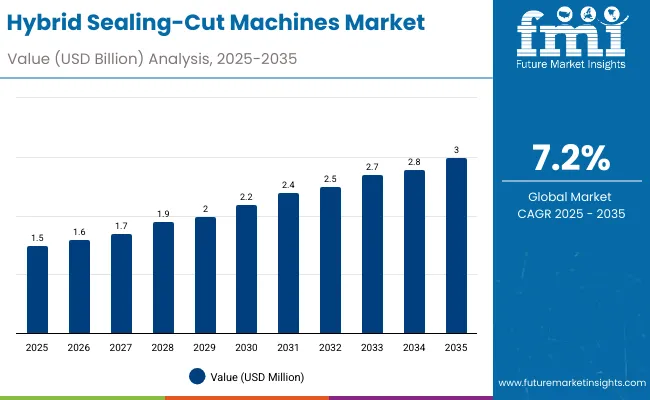
| Metric | Value |
|---|---|
| Industry Size (2025E) | USD 1.5 billion |
| Industry Value (2035F) | USD 3.0 billion |
| CAGR (2025 to 2035) | 7.2% |
Between 2025 and 2030, the market will add USD 0.6 billion, from food and pharmaceutical sectors. From 2030 to 2035, another USD 0.9 billion will emerge from advanced flexible packaging applications. Asia-Pacific leads growth, driven by industrial automation and film compatibility innovation.
From 2020 to 2024, hybrid sealing-cut machines evolved from conventional heat systems into dual-technology solutions integrating ultrasonic precision. Manufacturers focused on increasing sealing integrity, reducing waste, and improving energy efficiency. Demand surged in flexible packaging for food and pharmaceuticals.
By 2035, the market will reach USD 3.0 billion, growing at 7.2% CAGR. Laminated and biodegradable film compatibility will enhance usage in eco-friendly packaging. Asia-Pacific will dominate growth, while North America and Europe lead in precision engineering and laser-integrated models. The shift toward smart, energy-efficient sealing defines the next decade.
The hybrid sealing-cut machines market is expanding due to the global rise in flexible packaging, automation upgrades, and adoption of sustainable materials. Dual-technology sealing enhances product protection and packaging speed.
The food and pharmaceutical sectors drive adoption for sterilized, high-integrity packaging. Sustainability goals and lightweight material innovation further propel growth. Continuous R&D in hybrid heat-ultrasonic systems ensures operational precision and energy efficiency across packaging industries.
The market is segmented by machine type, technology, material compatibility, end-use industry, and region. Machine types include horizontal, vertical, rotary, and inline hybrids. Technologies comprise heat-ultrasonic, heat-laser, ultrasonic-mechanical, and infrared-pressure hybrids. Materials include laminated, PE, PP, PET, and biodegradable films. End-use industries span food, pharmaceuticals, electronics, and industrial manufacturing across major global regions.
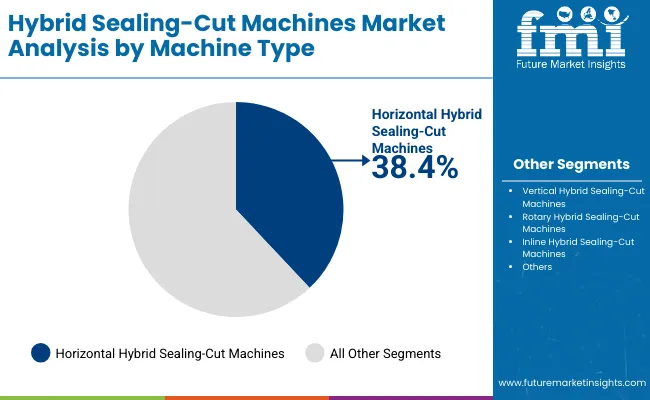
Horizontal machines will hold 38.4% share in 2025, valued for operational flexibility, sealing speed, and adaptability to diverse film types.
Future adoption will be driven by automation in snack, dairy, and ready-meal packaging lines. Enhanced servo controls and integrated cooling will further improve reliability.
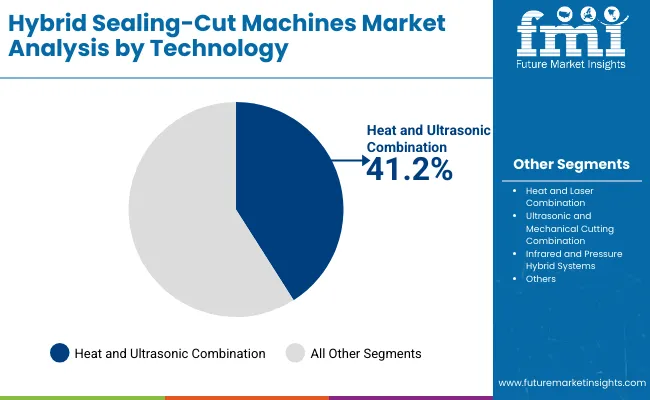
This technology will capture 41.2% share in 2025, ensuring superior sealing strength with reduced thermal load. It is widely used in food and medical-grade packaging.
By 2035, energy-efficient, digitally controlled systems will reinforce its leadership, minimize material distortion while improve throughput.
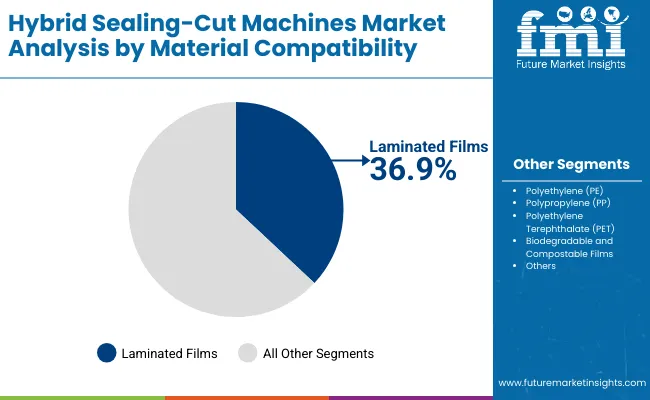
Laminated films will represent 36.9% share in 2025, owing to strong heat resistance and enhanced sealability. These films ensure durability for high-speed applications.
Growing preference for sustainable laminates and barrier properties will ensure steady growth through 2035.
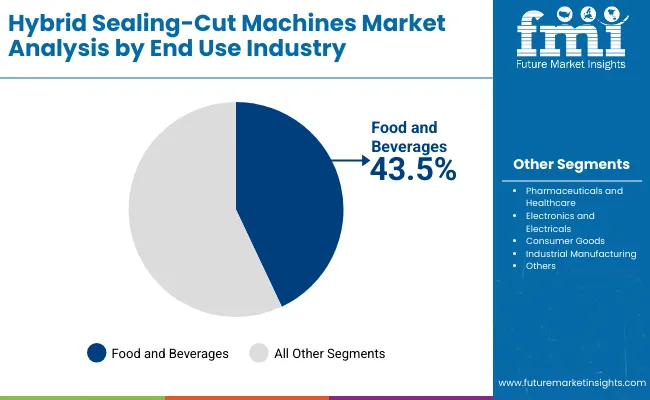
The food and beverage segment will account for 43.5% share in 2025, reflecting demand for vacuum-sealed, leak-proof packaging.
By 2035, adoption will expand across ready-to-eat meals, snacks, and frozen foods, supported by automation and sustainability integration.
Adoption is driven by increased automation, hybrid sealing efficiency, and eco-material compatibility. Hybrid technology reduces material damage, boosting productivity and energy conservation.
High costs of multi-technology integration and maintenance limit adoption among SMEs. Limited operator expertise in ultrasonic systems also hinders deployment.
Opportunities lie in automation integration with IoT and digital controls. Hybrid systems for biodegradable films offer strong growth potential in sustainable packaging.
Trends include laser-ultrasonic sealing, smart feedback sensors, and low-energy hybrid modules. Automation and digital diagnostics will reshape sealing line performance.
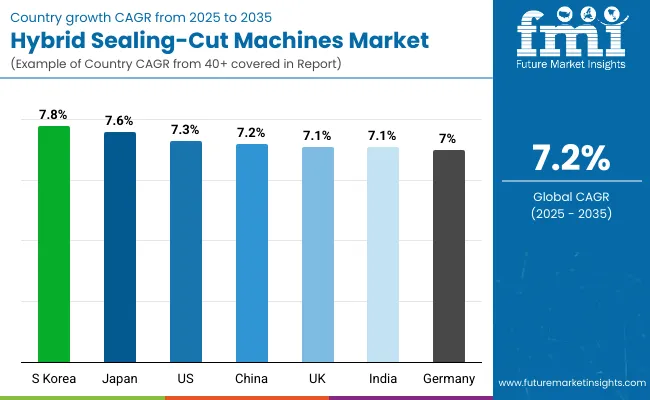
The hybrid sealing-cut machines market is expanding globally as flexible packaging and automation technologies converge. Asia-Pacific dominates growth, led by rapid industrial automation and strong FMCG production, while North America advances in high-speed precision packaging systems. Europe is emphasizing energy-efficient equipment and sustainable material integration to meet eco-compliance standards. Globally, the market is evolving toward hybrid sealing systems offering superior accuracy, reduced waste, and compatibility with recyclable packaging substrates.
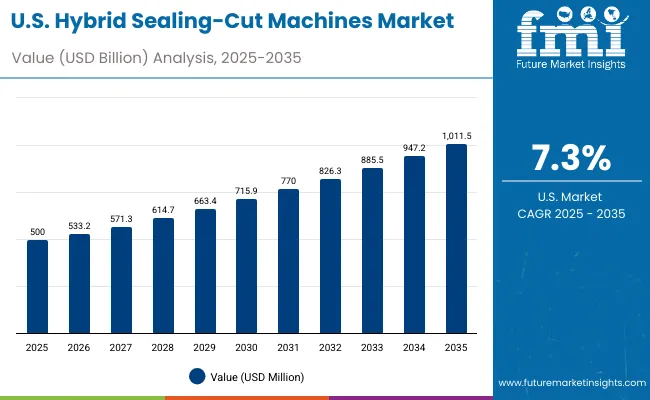
The USA market will grow at a CAGR of 7.3% from 2025 to 2035, driven by automation upgrades in food and pharmaceutical packaging lines. Companies are investing in hybrid sealing-cut systems for precision sealing and high throughput to meet regulatory compliance. The integration of IoT-enabled monitoring ensures greater consistency and safety. Sustainable packaging adoption is also reinforcing market growth as firms optimize production and minimize material wastage.
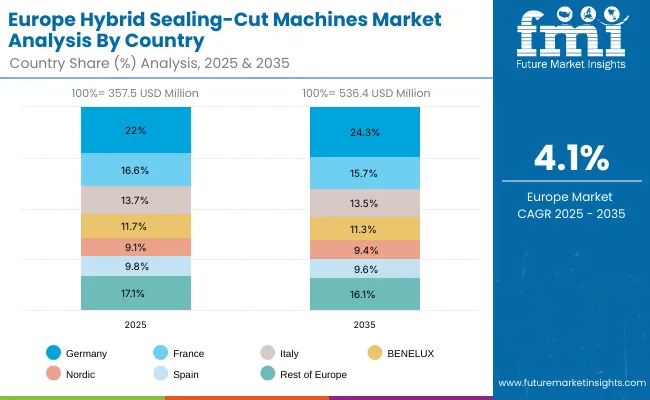
Germany is projected to expand at a CAGR of 7.0%, supported by EU sustainability mandates and demand for flexible packaging solutions. Manufacturers are prioritizing hybrid systems designed for recyclable and biodegradable materials. Energy-efficient sealing technologies are gaining prominence to reduce operational emissions. The integration of smart control systems and predictive maintenance software is enhancing reliability and performance across Germany’s advanced packaging lines.
The UK market will grow at a CAGR of 7.1%, driven by advanced automation initiatives across food, beverage, and healthcare sectors. Local producers are investing in hybrid sealing machines to support export packaging and sustainability goals. Integration of digital monitoring and AI-assisted control systems is improving process optimization. The government’s plastic reduction policies and the growth of smart factories are further boosting adoption in flexible packaging industries.
China will expand at a CAGR of 7.2%, supported by mass automation in FMCG, pharmaceutical, and electronics packaging sectors. Domestic manufacturers are developing cost-effective hybrid sealing systems capable of handling multi-layer flexible films. Government initiatives for advanced manufacturing are driving adoption in export-oriented packaging operations. Rising demand for high-speed, precision sealing in consumer goods production strengthens China’s leadership in hybrid sealing technology.
India will grow at a CAGR of 7.1%, fuelled by industrial expansion in food, beverage, and pharmaceutical packaging. Hybrid sealing-cut systems are increasingly used to modernize FMCG production lines and reduce human intervention. The focus on affordability and energy efficiency is driving adoption among SMEs. Export-oriented manufacturers are upgrading to hybrid sealing machines to enhance sealing integrity, shelf-life performance, and compliance with global packaging standards.
Japan will grow at a CAGR of 7.6%, led by robotics-driven sealing automation and innovations in compact system design. The market’s precision engineering expertise supports demand for high-speed hybrid sealing machines used in medical-grade and food packaging. Integration of robotics enhances sealing uniformity and performance accuracy. Compact, energy-efficient systems are preferred for limited-space industrial setups, aligning with Japan’s focus on sustainable and efficient manufacturing.
South Korea is expected to lead growth with a CAGR of 7.8%, driven by smart automation and robotics integration in packaging industries. Electronics, food, and cosmetic sectors are adopting hybrid sealing-cut machines for precise, high-speed production. AI-enabled systems are improving real-time diagnostics and operational efficiency. The country’s emphasis on smart factories and advanced automation solidifies its position as a technological hub for modern packaging solutions.
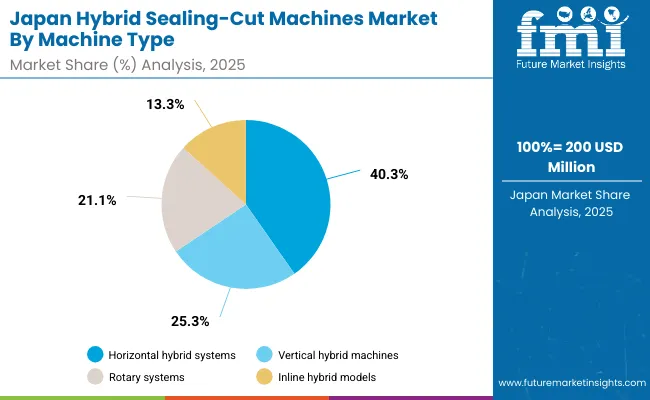
Japan’s hybrid sealing-cut machines market, valued at USD 200 million in 2025, is led by horizontal hybrid systems with a 40.3% share, owing to their efficiency in pouch and flexible film packaging. Vertical hybrid machines hold 25.3%, driven by compact automation and vertical form-fill-seal use. Rotary systems capture 21.1%, ensuring precision for continuous operations in high-output lines. Inline hybrid models, with a 13.3% share, are gaining attention for modular integration with digital packaging platforms. Growth is supported by smart control adoption, enhanced energy efficiency, and demand for high-speed hybrid sealing solutions in Japan’s advanced packaging industry.
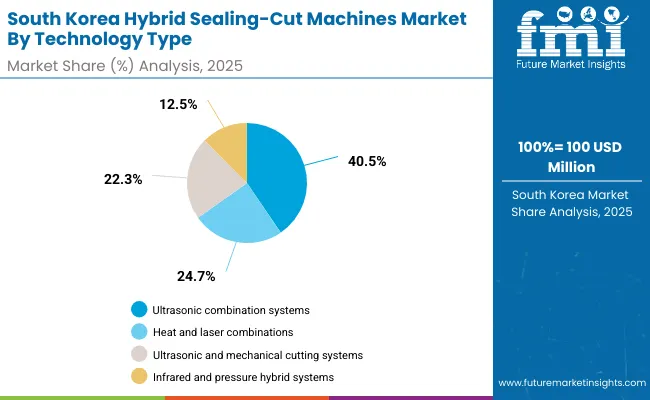
South Korea’s market, estimated at USD 100 million in 2025, is dominated by heat and ultrasonic combination systems with a 40.5% share, favoured for reduced seal distortion and energy savings. Heat and laser combinations hold 24.7%, enhancing precision in thin polymer films. Ultrasonic and mechanical cutting systems capture 22.3%, offering speed and reliability for multilayer laminates. Infrared and pressure hybrid systems, at 12.5%, are used for specialty materials requiring uniform sealing. Growth in South Korea is reinforced by smart manufacturing initiatives, eco-efficient packaging lines, and continuous R&D in hybrid motion control and sealing technologies.
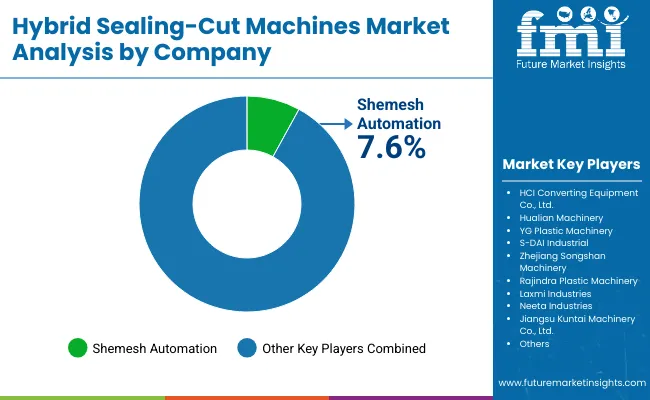
The market is moderately fragmented with leading players including Shemesh Automation, HCI Converting Equipment, Hualian Machinery, YG Plastic Machinery, S-DAI Industrial, Zhejiang Songsnan Machinery, Rajindra Plastic Machinery, Laxmi Industries, Neeta Industries, and Jiangsu Kuntai Machinery. These companies focus on modular hybrid technologies and film versatility.
Shemesh Automation and HCI lead innovation in ultrasonic-laser integration. YG Plastic Machinery and Rajindra Plastic Machinery emphasize cost-effective systems for emerging markets. S-DAI Industrial and Laxmi Industries focus on energy efficiency and real-time monitoring, intensifying global competition.
Key Developments of Hybrid Sealing-Cut Machines Market
| Item | Value |
|---|---|
| Quantitative Units | USD 1.5 Billion |
| By Machine Type | Horizontal, Vertical, Rotary, Inline Hybrids |
| By Technology | Heat & Ultrasonic, Heat & Laser, Ultrasonic & Mechanical, Infrared & Pressure Systems |
| By Material Compatibility | Laminated, PE, PP, PET, Biodegradable Films |
| By End-Use Industry | Food & Beverages, Pharmaceuticals, Electronics, Consumer Goods, Industrial Manufacturing |
| Key Companies Profiled | Shemesh Automation, HCI Converting Equipment, Hualian Machinery, YG Plastic Machinery, S-DAI Industrial, Zhejiang Songsnan Machinery, Rajindra Plastic Machinery, Laxmi Industries, Neeta Industries, Jiangsu Kuntai Machinery |
| Additional Attributes | Growth driven by dual-technology automation, sustainable films, and energy-efficient sealing lines. |
The market will be valued at USD 1.5 billion in 2025.
The market will reach USD 3.0 billion by 2035.
The market will grow at a CAGR of 7.2% during 2025-2035.
Horizontal hybrid sealing-cut machines will lead with a 38.4% share in 2025.
Heat and ultrasonic combination will dominate with a 41.2% share in 2025.






Our Research Products

The "Full Research Suite" delivers actionable market intel, deep dives on markets or technologies, so clients act faster, cut risk, and unlock growth.

The Leaderboard benchmarks and ranks top vendors, classifying them as Established Leaders, Leading Challengers, or Disruptors & Challengers.

Locates where complements amplify value and substitutes erode it, forecasting net impact by horizon

We deliver granular, decision-grade intel: market sizing, 5-year forecasts, pricing, adoption, usage, revenue, and operational KPIs—plus competitor tracking, regulation, and value chains—across 60 countries broadly.

Spot the shifts before they hit your P&L. We track inflection points, adoption curves, pricing moves, and ecosystem plays to show where demand is heading, why it is changing, and what to do next across high-growth markets and disruptive tech

Real-time reads of user behavior. We track shifting priorities, perceptions of today’s and next-gen services, and provider experience, then pace how fast tech moves from trial to adoption, blending buyer, consumer, and channel inputs with social signals (#WhySwitch, #UX).

Partner with our analyst team to build a custom report designed around your business priorities. From analysing market trends to assessing competitors or crafting bespoke datasets, we tailor insights to your needs.
Supplier Intelligence
Discovery & Profiling
Capacity & Footprint
Performance & Risk
Compliance & Governance
Commercial Readiness
Who Supplies Whom
Scorecards & Shortlists
Playbooks & Docs
Category Intelligence
Definition & Scope
Demand & Use Cases
Cost Drivers
Market Structure
Supply Chain Map
Trade & Policy
Operating Norms
Deliverables
Buyer Intelligence
Account Basics
Spend & Scope
Procurement Model
Vendor Requirements
Terms & Policies
Entry Strategy
Pain Points & Triggers
Outputs
Pricing Analysis
Benchmarks
Trends
Should-Cost
Indexation
Landed Cost
Commercial Terms
Deliverables
Brand Analysis
Positioning & Value Prop
Share & Presence
Customer Evidence
Go-to-Market
Digital & Reputation
Compliance & Trust
KPIs & Gaps
Outputs
Full Research Suite comprises of:
Market outlook & trends analysis
Interviews & case studies
Strategic recommendations
Vendor profiles & capabilities analysis
5-year forecasts
8 regions and 60+ country-level data splits
Market segment data splits
12 months of continuous data updates
DELIVERED AS:
PDF EXCEL ONLINE
Hybrid Additive Manufacturing Machines Market Size and Share Forecast Outlook 2025 to 2035
Hybrid Sleeve Cartridges Market Analysis - Size and Share Forecast Outlook 2025 to 2035
Hybrid Reactive Power and Harmonic Compensation Device Market Size and Share Forecast Outlook 2025 to 2035
Hybrid Vision Sensor Chips Market Size and Share Forecast Outlook 2025 to 2035
Hybrid Printing Market Forecast Outlook 2025 to 2035
Hybrid Boat Market Size and Share Forecast Outlook 2025 to 2035
Hybrid Metal-Paper Seamers Market Size and Share Forecast Outlook 2025 to 2035
Hybrid Powertrain Market Size and Share Forecast Outlook 2025 to 2035
Hybrid Integration Platform Market Size and Share Forecast Outlook 2025 to 2035
Hybrid Marine Gensets Market Size and Share Forecast Outlook 2025 to 2035
Hybrid Meat Products Market Size and Share Forecast Outlook 2025 to 2035
Hybrid Generator Sets Market Size and Share Forecast Outlook 2025 to 2035
Hybrid Switchgear Market Size and Share Forecast Outlook 2025 to 2035
Hybrid Rice Seeds Market Size and Share Forecast Outlook 2025 to 2035
Hybrid Memory Cube Market Size and Share Forecast Outlook 2025 to 2035
Hybrid Aircraft Market Size and Share Forecast Outlook 2025 to 2035
Hybrid Solar Wind Market Size and Share Forecast Outlook 2025 to 2035
Hybrid Cutters Market Analysis Size and Share Forecast Outlook 2025 to 2035
Hybrid Fabrics Market Size and Share Forecast Outlook 2025 to 2035
Hybrid Train Market Analysis - Size, Share, and Forecast Outlook 2025 to 2035

Thank you!
You will receive an email from our Business Development Manager. Please be sure to check your SPAM/JUNK folder too.
Chat With
MaRIA